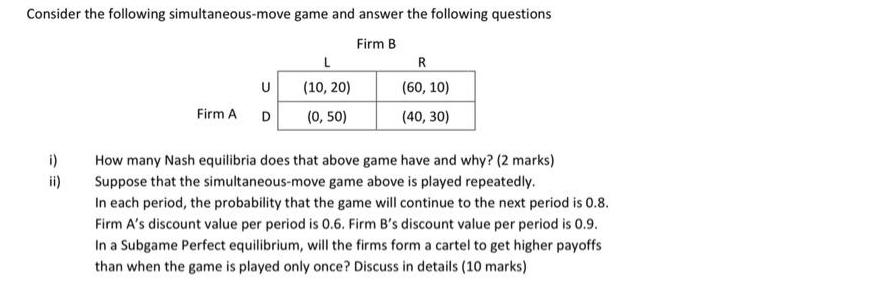Question
Consider the following simultaneous-move game and answer the following questions Firm B L R U (10, 20) (60, 10) Firm A D (0, 50)

Consider the following simultaneous-move game and answer the following questions Firm B L R U (10, 20) (60, 10) Firm A D (0, 50) (40, 30) i) How many Nash equilibria does that above game have and why? (2 marks) Suppose that the simultaneous-move game above is played repeatedly. In each period, the probability that the game will continue to the next period is 0.8. Firm A's discount value per period is 0.6. Firm B's discount value per period is 0.9. In a Subgame Perfect equilibrium, will the firms form a cartel to get higher payoffs than when the game is played only once? Discuss in details (10 marks)
Step by Step Solution
There are 3 Steps involved in it
Step: 1
i Nash equilibrium is a situation where a firm is playing its best strategy given what the opponent ...
Get Instant Access to Expert-Tailored Solutions
See step-by-step solutions with expert insights and AI powered tools for academic success
Step: 2

Step: 3

Ace Your Homework with AI
Get the answers you need in no time with our AI-driven, step-by-step assistance
Get StartedRecommended Textbook for
Microeconomics An Intuitive Approach with Calculus
Authors: Thomas Nechyba
1st edition
538453257, 978-0538453257
Students also viewed these Economics questions
Question
Answered: 1 week ago
Question
Answered: 1 week ago
Question
Answered: 1 week ago
Question
Answered: 1 week ago
Question
Answered: 1 week ago
Question
Answered: 1 week ago
Question
Answered: 1 week ago
Question
Answered: 1 week ago
Question
Answered: 1 week ago
Question
Answered: 1 week ago
Question
Answered: 1 week ago
Question
Answered: 1 week ago
Question
Answered: 1 week ago
Question
Answered: 1 week ago
Question
Answered: 1 week ago
Question
Answered: 1 week ago
Question
Answered: 1 week ago
Question
Answered: 1 week ago
Question
Answered: 1 week ago
Question
Answered: 1 week ago
View Answer in SolutionInn App



